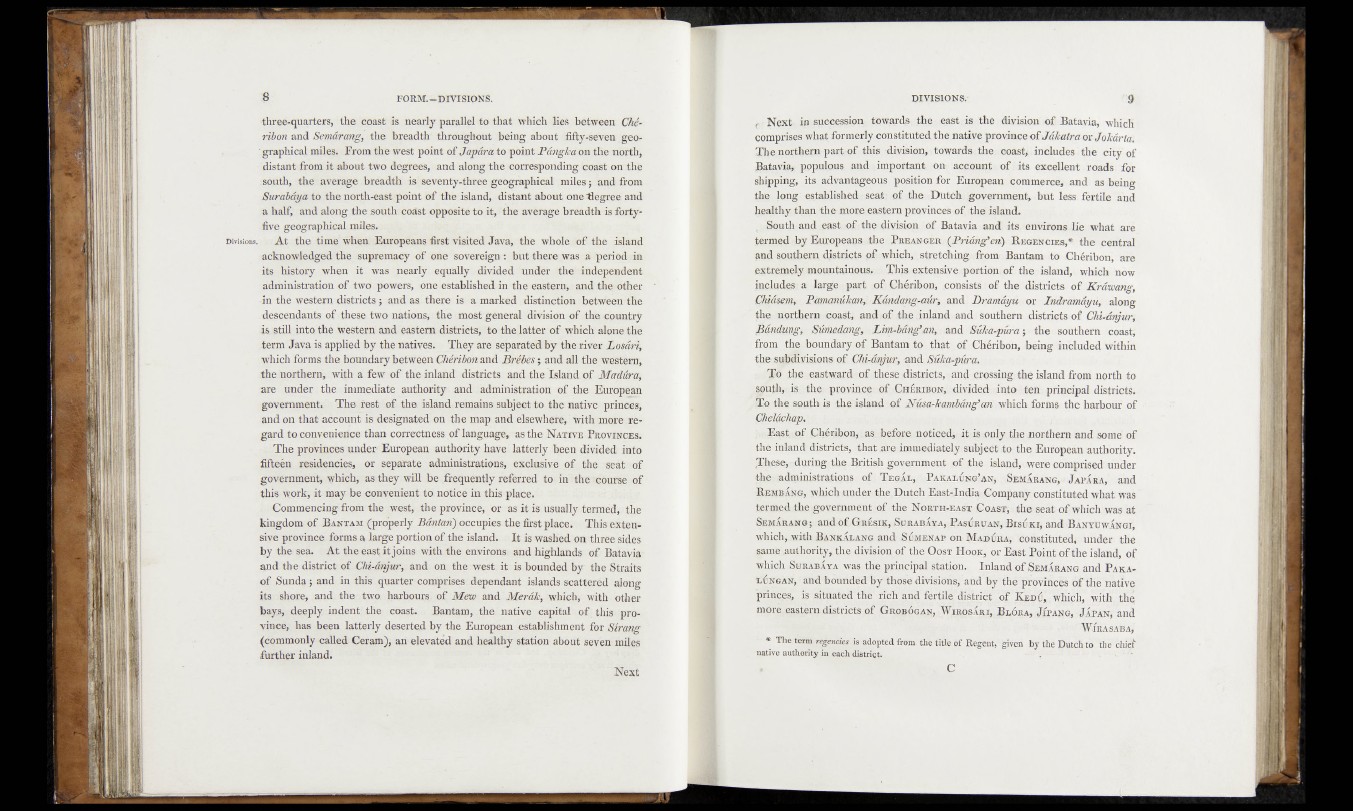
-three-quarters, the coast is nearly parallel to that which lies between Ché-
ribon and Semarang, the breadth' throughout being about .fifty-seven geographical
miles. From the west point of Japara to point Pdngka-on the north,
distant from it about two degrees, and along the corresponding coast on the
south, the average breadth is seventy-three geographical miles; and from
Surabaya to the north-east point of the island, distant about one degree and
a half, and along the south coast opposite to it, the average breadth is forty-
five geographical miles..
Divisions. At the time when Europeans first visited Java, the whole. of the island
acknowledged the supremacy of one sovereign : but there was a period in
its history when it was nearly equally divided under the. independent
administration of two powers, one established in the eastern, and the other
-in the western districts; and as there is a marked distinction between the
descendants of these two nations, the most general division of the country
is„ still into, the western and eastern districts, to the latter of which alone the
term Java is. applied by the natives. They are separated by the river Losdri,
which forms the boundary between Chêribón and lirébes; and all the western,
the northern, with a few of the inland districts and- the Island of Madéra,
are under th e . immediate authority and administration of the European
-government. The rest of' the. island.remains subject to the native princes,
and on that account- is designated on the map and elsewhere, with more .regard
to convenience than correctness of language, as the Native Provinces.
The provinces under European authority have, latterly been divided into
fifteen residencies, or separate administrations, exclusive of the seat, of
government, which, as they will be .frequently referred to mSthre 'course of
this work, it may be convenient to. notice in this place.
. Commencing-from the west, the province, or as it is usually termed, the
kingdom of Bantam (properly iiaufeu) occupies.the first place. This; extensive
province forms a large portion of the island. It is washed On three sides
by the sea. At the east it joins with, the environs and highlands of Batavia-
and the district of Chi-dnjur, and. on the west, it is bounded by the Straits
of Sunda; and in this quarter comprises dependant islands scattered along
its shore, and the; two. harbours, of Mew axA Merak, which, with other
bays, deeply indent; the coast.. . Bantam, the. native capital of this province,
has been latterly deserted by thé European establishment for Slrang
(commonly called Ceram), an elevated and healthy station about seven miles
further inland.
Next
-•Neact ip .succession- towards* the east, is the division of; Eatavia, which
comprises what formerly, constituf ed,f he. native province of Jakatra oxJokartdi
Thenorthern-part-pf this -.division, towards.the coast*.includes the city of
Batavf% populous and important on- account of its excellent. roads for
shipping, its advantageous position for European commerce, and as being
the long established seat; of the, Dutch/ government, but less fèrtile and
healthy than the more eastern provinces of the island.
f.. South and east .of .-the division óf Batavia and its. environs lie what are
termed • by Europeans, ifche P r e a n g e r (Pridhgfeii) • R e g e n c i e s , * the central
£nd southern districts pf which,. stretching/,-from Bantam to Ghéribon, are
extremely mountainous. This,-extensive .portion.*of the-island,-, which now
jneludssj a large, part rofj Cherikon* ^consists ©£ the districts of Krawoang,
Qrnsm, Papmnukan,, Kdndang-aur, and Dramdyu or •Indramayu, along
(he northern .coast, and .of the. inland and southern .districts of Chi-dnjur;
JBdndmgi Sumexbmg, iLim-bdng'm, and Suka-pura; - the southern coast;
from (th&t'boundary-pf, Bantam tp ,that^crf Chéribon, being included within
the subdivisions-of Chi-dpjur, arid Süka-püra.
■ To Jfehp eastward of these .districts, - and crossing; thé island from north to
south,r is ,-thei province-of,GHÉRa'BONw!TdlyidediriutO'.ten,principal districts.
To the south-is thé island of :NM$a-kamhdng’an which, forms the harbour of
Gheldchap.,
/HiFSjSloPf fjhéribon,. as, before noticfed;, itrisionly the northern and some' of
the inland'-districts, /that .are imni’ediatiely subjectto' the European authority.
^SieS^nd^n^Ae British government jof the island,were comprised under
#gi.dadm«irtrstip»s of Tegajé, PakauungJan, SemIrangj« J apXra,’ and
B emrang, which-under the,Dutch East-IndiaBCompanyconstituted.what was'
ter inedlhe -;gpvernment<of the North-east Coast; the-seat of which was at
Semarang; and o£.Gresik,S urabaya, Pascruan*BisÓ<ki, andBanyuwXngU
which-,, .with Banjcalang and Sémenap on Majjura, constituted, under the
■same .authority,, (he division of the Oost HooE^or East Point* of the island, of
W/hich Shraba-ta was the principal station. Inland of SemXkang and Paka-
IdéNGAN, and bounded by0 those dMsióhs, and by thé ’prövintës the native
'princes, .is situated the rich and'fertilfe "djsjtrict of Kedu, which, with the
more „eastern-jdisirict^pf Grobóga.n, ^ irosari, , Blóra, Jipaa[g, Japan, and
■ ’ WfilASABA,
* The term regencies Adopted from the fitte Sf Regent* ’given by the Diitcli tö 'thechi'ê
native authority in each district.
c